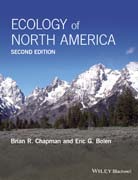
North America contains an incredibly diverse array of naturalenvironments, each supporting unique systems of plant and animallife. These systems, the largest of which are biomes, formintricate webs of life that have taken millennia to evolve. Thisrichly illustrated book introduces readers to this extraordinaryarray of natural communities and their subtle biological andgeological interactions. Completely revised and updated throughout, the second edition ofthis successful text takes a qualitative, intuitive approach to thesubject, beginning with an overview of essential ecological termsand concepts, such as competitive exclusion, taxa, niches, andsuccession. It then goes on to describe the major biomes andcommunities that characterize the rich biota of the continent,starting with the Tundra and continuing with Boreal Forest,Deciduous Forest, Grasslands, Deserts, Montane Forests, andTemperature Rain Forest, among others. Coastal environments,including the Laguna Madre, seagrasses, Chesapeake Bay, and barrierislands appear in a new chapter. Additionally, the book covers manyunique features such as pitcher plant bogs, muskeg, the polar icecap, the cloud forests of Mexico, and the LaBrea tar pits. Infoboxes have been added; these include biographiesof historical figures who provided significant contributions to thedevelopment of ecology, unique circumstances such as frogs andinsects that survive freezing, and conservation issues such asthose concerning puffins and island foxes. Throughout the text,ecological concepts are worked into the text; these includebiogeography, competitive exclusion, succession, soil formation,and the mechanics of natural selection. Ecology of North America 2e is an ideal first text forstudents interested in natural resources, environmental science,and biology, and it is a useful and attractive addition to thelibrary of anyone interested in understanding and protecting thenatural environment. INDICE: FOREWORD.PREFACE.CHAPTER ONE Introduction.A BRIEF OVERVIEW OF ECOLOGY.The Ecosystem.Abiotic Limits.Climate and Topography.Soils and Soil Profiles.Biotic Community.COMMUNITY SUCCESSION.Plant Succession: from Pioneer to Climax.Primary and Secondary Succession.Succession and Species Abundance.The Biome Concept.BIODIVERSITY.The Species Diversity Gradient .Biodiversity Hotspots.PATTERNS OF DISTRIBUTION.Continental patterns.Geographical and Ecological Distribution.SOME ECOLOGICAL CONCEPTS.Niches.Ecological Equivalents.Bergmann Rule.Allen s Rule.READINGS AND REFERENCES.CHAPTER TWO Tundra.CLIMATIC AND GLACIAL INFLUENCES.Soils and Geological Influences.Permafrost.Patterned Ground.Eskers and Tundra Wildlife.Glacial Refugia.FEATURES AND ADAPTATIONS.Plant Adaptations to Harsh Conditions.Plant Growth and Reproduction.Decomposition and Soil Nutrients.Some Animal Adaptations.MAJOR VEGETATIVE COMMUNITIES.Shrub Tundra.Dwarf Birch–Heath.Cottongrass–Heath.Fellfields.INVERTEBRATES AND TUNDRA ECOLOGY.SELECTED TUNDRA MAMMALS.Lemmings.Arctic Ground Squirrels.Arctic Foxes.Barren–Ground Caribou.SELECTED TUNDRA BIRDS.Gryfalcons.Snowy Owl.Ross Goose.HIGHLIGHTS.Absentees Amphibians and Reptiles.Lichens and Reindeer Moss .Snow Goose Eat Outs .ALPINE TUNDRA.FRAGILE TUNDRA.Impacts of Human Activity.Global Warming.READINGS AND REFERENCES.CHAPTER THREE Boreal Forest.CLIMATIC BOUNDARIES AND SOILS.FEATURES AND ADAPTATIONS.Plant Adaptations.Animal Adaptations.Frequent Fires.Niches in the Boreal Forest.SELECTED BIOTIC COMMUNITIES.Tree Line and Forest–Tundra.Muskeg.Coniferous Swamps.Comparative Ecology of Lakes.Appalachian Extension.Mountain Balds.HIGHLIGHTS.The 10–Year Cycle.Wolves and Moose.A Wealth of Salamanders.Red Squirrels.ECOLOGICAL CHALLENGES.Acid Rain.Spruce Budworm and DDT.Balsam Wooly Adelgid.THE BOREAL FOREST AGREEMENT.READINGS AND REFERENCES.CHAPTER FOUR Eastern Deciduous Forest.CLIMATIC BOUNDARIES AND SOILS.FEATURES AND ADAPTATIONS.The Forest Primeval.The Layered Forest .Autumn Leaves.Ground and Leaf Litter.Mast.BIOTIC ASSOCIATIONS.Northern Hardwoods–Conifer Forests.Beech–Maple–Basswood.Mesophytic Forest.Oak–Hickory.Mississippi Alluvial Plain.Southern Mixed Forest.SOME ASSOCIATED COMMUNITIES.Longleaf Pine Forests.New Jersey Pine Barrens.Carolina Bays.HIGHLIGHTS.Acorns and Blue jays.Deer Yards.Kirtland s Warblers and Fire.Franklin s Lost Tree.Cicadas: A Buzz in the Forest.ECOLOGICAL CHALLENGES.Declines of Neotropical Migrants.Forest Destruction by Exotic Organisms.Reintroduction of Red Wolves.READINGS AND REFERENCES.CHAPTER FIVE Grasslands: Prairies and Plains.MAJOR ASSOCIATIONS.Tallgrass Prairie.Midgrass Prairie.Shortgrass Prairie.TRANSITION ZONES.Aspen Parklands.Cross Timbers.Western Transition.FEATURES AND ADAPTATIONS.Seasonal Grasses.Soils.Role of Fire.Prairie Streams.Prairie Wetlands and Waterfowl.PLEISTOCENE EXTINCTIONS.SELECTED PRAIRIE MAMMALS.Bison.Prairie Dogs.Pronghorns.SELECTED PRAIRIE BIRDS.Prairie Chickens.Burrowing Owls.HIGHLIGHTS.Riparian Forests.The Platte River.Nebraska Sandhills.Ants.Isolation and Contact on the Great Plains.GRASSLAND SETTLEMENT.PRAIRIE PRESERVATION.READINGS AND REFERENCES.CHAPTER SIX Regional Grasslands and Related Areas.REGIONAL ASSOCIATIONS.Palouse Prairie.California Annual Grasslands.Southwestern Desert Grasslands.Edwards Plateau.Tamaulipan Mezquital.HIGHLIGHTS.Rodents and Vegetation.Channeleed Scablands.Snake River Birds of Prey Area.Mima Mounds.DESERTIFICATION.READINGS AND REFERENCES.CHAPTER SEVEN Deserts.PHYSICAL GEOGRAPHY.Why Deserts are Dry.Desert Mountains and Bajadas.Ancient Lakes.FEATURES AND ADAPTATIONS.Desert Soils and Surfaces.Plant Adaptations .Animal Adaptations.THE MAJOR DESERTS.Chihuahuan Desert.Sonoran Desert.Mojave Desert.Great Basin Desert.HIGHLIGHTS.Nurse Trees. Trees for Desert Woodpeckers.Boojums and Elephants: Unique Trees.Yucca Moths.Desert Fishes.Realm of Reptiles.Of Soils and Mice.Deserts and Predators.Pygmies of the Sagebrush Steppe.Desert Quail, Rainfall, and Vitamin A.Sailing Stones.WHEELED THREATS TO DESERTS.READINGS AND REFERENCES.CHAPTER EIGHT Chaparral and Pinyon–Juniper Woodlands.FEATURES AND ADAPTATIONS OF CHAPARRAL.COASTAL (CALIFORNIA) CHAPARRAL.Chamise Chaparral.Manzanita Chaparral.Ceanothus Chaparral.Other Chaparral Communities.INTERIOR (ARIZONA) CHAPARRAL.PINYON–JUNIPER WOODLANDS.Distribution and Ecology.Human Uses.CHAPARRAL AND FIRE.Water–Repellant Soils.Post–Fire Vegetation.Wildlife and Chaparral Fire.HIGHLIGHTS.Allelopathy in Chaparral.Animal Associates of Chaparral.Lizards and Burned Chaparral.Pinyon Jays.HUMAN INFLUENCES.READINGS AND REFERENCES.CHAPTER NINE Montane Forests.FEATURES AND ADAPTATIONS.MONTANE FOREST ZONES.Lower Montane Zone.Upper Montane Zone.Subalpine Zone.ASSOCIATED HABITATS.Mountain Parks and Meadows.Black Hills.Redwoods and Sequoias.Bristlecone Pine Forest.FIRE IN MONTANE FORESTS.Western Chipmunks and Competitive Exclusion.Squirrels, Bears, and Pine Cones.Sky Islands in Arizona.Monarchs in Winter.Bears and Moths.READINGS AND REFERENCES.CHAPTER TEN Temperate Rain Forest.WHAT IS OLD–GROWTH FOREST?.FEATURES AND ADAPTATIONS.Valleys of Rain Forest.Epiphytes, Canopy Roots, and Scuzz .More About Logs.Succession on Glacial Till.HIGHLIGHTS.Bears, Salmon, and Forest Enrichment.A Seabird in the Forest.Some Mammals and Their Ecology.Bananna Slugs.Pacific Yew.Giant Salamanders and Other Amphibians.Mount St. Helens.ECOLOGICAL CONTROVERSY.READINGS AND REFERENCES.CHAPTER ELEVEN Coastal Environments.CURRENTS AND CLIMATES.FEATURES AND ADAPTATIONS.Rocky Seashores and Tidal Pools.Sandy Seashores.Chesapeake Bay.The Mother Lagoon.SUBMERGENT COMMUNITIES.Seagrass Meadows.Forests in the Ocean.Oyster Reefs.EMERGENT COMMUNITIES.Atlantic Tidal Marshes.Marshes of the Gulf Coast.Mangrove Islands and Thickets.SOME ASSOCIATED COMMUNITIES.Barrier islands.Coral Reefs.Maritime Forests.HIGHLIGHTS.Synchrony at Delaware Bay.Waterbird Colonies.A Whale of a Success.ECOLOGICAL CHALLENGES.Natural Disturbances.Sea Level Rise.READINGS AND REFERENCES.CHAPTER TWELVE A Selection of Special Environments.SPECIAL ENVIRONMENTS.Niagara Escarpment.Caves.Arctic Ice Cap.The Grand Canyon.Father of Waters.The Everglades.Fossil Lagerstätten.The Florida Keys.The Great Lakes.HABITAT HIGHLIGHTS.Rivers of Ice.Hot Springs and Geysers.Forest in the Clouds.Granite Outcrops and Inselbergs.Palm Forest.Mineral Licks.Bogs and Their Carnivorous Plants.READINGS AND REFERENCES.APPENDIX.GLOSSARY.INDEX
- ISBN: 978-1-118-97154-3
- Editorial: Wiley–Blackwell
- Encuadernacion: Cartoné
- Páginas: 376
- Fecha Publicación: 12/06/2015
- Nº Volúmenes: 1
- Idioma: Inglés
